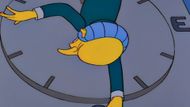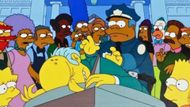What started as a string of cartoon short movies later grew into a pop culture empire built upon five smiling yellow icons. Matt Groening's creation, The Simpsons, initially hit television screens in 1989 with a sarcastic, satirical take on life in America—via the misadventures of the forever friendly (and forever dysfunctional) Simpson family: Homer, Marge, Bart, Lisa, and infant Maggie.
The show remains on the air with more than 790 episodes, making it the longest-running American animated TV series, sitcom, and scripted primetime series in television history.
So what's the secret? The perfect blend of laugh-out-loud jokes, blink-and-you'll-miss-'em depth, and seriously unexpected social commentary. And don't even attempt to get us started on Springfield—the wacky, nutty, and somehow recognizable town full of side characters you'll never be able to shake.
From comic book nerd nerds to TV clowns and overworked schoolteachers, these supporting actors and actresses add something new to each rewatch. But still, it's the Simpsons themselves who are the true stars—Homer's shenanigans, Marge's saintly patience, Bart's bad boy behavior, Lisa's intelligence, and Maggie's quiet-but-sassy star power.
And of course, discussing impossible-to-forget characters—no one does villainy better than Mr. Burns. The Springfield evil billionaire: old, sadistic, and completely out of touch. Whether he's shading the sun or pilfering all the town's resources, Mr. Burns is the kind of bad guy you love to boo—cold, calculating, and completely iconic.
And then 1995 arrived and The Simpsons pulled off one of its most audacious stunts of all time: a straightforward murder mystery. Who Shot Mr. Burns? was a two-parter summer-long cliffhanger that had armchair detectives around the globe speculating about the killer.
With tips of the hat to vintage whodunits, a complex network of suspects, and a good measure of plot twists, the mystery became one of the program's most long-lived storylines—and a TV highlight.
Let's examine in greater detail Who Shot Mr. Burns?—how it was built, why everyone was searching, and what it tells us about The Simpsons at its finest.
Welcome to Springfield: The hometown of The Simpsons and a whole lot of oddballs

At the heart of The Simpsons are the one and only Simpson family—a wacky, daffy, and incredibly poignant reimagining of the classic American family.
Homer is the donut-loving dad who toils at a nuclear power plant (ask him no questions, he'll tell you no lies). He's lazy, oblivious, and always wreaking havoc—yet he loves his family with all his cheeseburgers-and-fries heart.
Blue-haired, tolerant Marge is the glue that holds the family together. She's the voice of reason amidst the chaos, most often cleaning up after Homer's messes—literally and figuratively.
Bart is your 10-year-old troublemaker. He's a master of pranks, a skateboard master, and inexplicably never appears to have homework.
Lisa is just the opposite. Lisa is 8 years old, an A-student, a sax player, and a reader of much more than a half-grown child her age. Lisa is the moral compass of The Simpsons, always considering right and wrong and attempting to improve the world.
Maggie might be the baby, but don't be mistaken. She doesn't say much, but she's smarter (and sneakier) than you're letting on.
But without the comedic characters that inhabit the town of Springfield, The Simpsons would not be the same show. The supporting cast is the show's secret ingredient.
There's Smithers, the adoringly dedicated sidekick with a not-so-secret infatuation with his boss. Principal Skinner, who receives no respect in school (or from his mother). Moe, the gruff bartender with a heart of gold, is buried deep under sarcasm. Apu, stuck behind the counter at the Kwik-E-Mart with a "thank you, come again."
And that's only the start—throw in Mayor Quimby, Flanders, Krusty the Clown, Chief Wiggum, and you've got a town like no other.
And looming above them all—literally and in villainy—is Mr. Burns.
He is the aged, fabulously rich owner of the nuclear power station and Springfield's closest living approximation to a monster. Burns is greedy, cold-blooded, and laughingly out of touch (he still believes it's 1930).
If he's blocking out the sun or firing an employee for blinking in the wrong direction, he's the perfect bad guy—evil, legendary, and just a pleasure to despise.
Who shot Mr. Burns? The Simpsons' greatest whodunit

In 1995, The Simpsons pulled off the impossible—nobody thought it would happen—with a straight-up murder mystery, complete with a cliffhanger. The two-part episode, Who Shot Mr. Burns?, was the Season 6 finale and Season 7 premiere, and everyone was playing detective all summer long.
The scenario was a good ol' Springfield chaos. Springfield Elementary hits black gold as the school finds oil beneath the playground, and their financial troubles are no more.
Naturally, though, Mr. Burns, being Mr. Burns, comes along and cooks up a plan to steal the oil for himself. His plan wrecks the school and messes with half the town’s lives, making him even more hated than usual.
But he does not quit. In classic evil-genius style, Mr. Burns declares his most absurd scheme ever: a huge disc to shield the sun. Why? So the whole town must pay for his nuclear power plant to produce electricity. Yeah—he attempts to steal daylight.
By this point, everyone in Springfield has a reason to want him gone. And when he arrives at a town meeting, the tensions are at a boil. Before long, Burns is walking alone down an alley... and boom—shot down by a mysterious assassin. He falls onto the sundial of the town, finger pointing ominously in death, and the screen goes black.
Who pulled the trigger? Who had the motive and the guts? Nobody knew, and that was precisely the way The Simpsons intended it.
Part two: Who done it?

When Part Two begins, Mr. Burns is still in a coma, and Springfield is in full-blown panic mode. Chief Wiggum and the town police (just as laughably incompetent as always) begin an investigation—but don't expect this to be CSI.
In a flash, there are two clear suspects: Smithers, just fired and is completely losing it, and Homer, who's been driven nuts after being royally disrespected by Mr. Burns on the job. Homer’s even been so ignored by Burns that the man literally can’t remember his name.
Smithers confesses to the crime... only to realize he was intoxicated and, in a befuddled state of inebriation, killed old Jasper in the wooden leg. One by one, other suspects such as Principal Skinner, Moe, and even Tito Puente are eliminated with alibis and comedic side evidence.
And then the break: the police find an eyelash on Mr. Burns's coat, and it's a DNA match for Homer. It just keeps heating when Burns comes to enough to whisper, "Homer Simpson," before lapsing back into unconsciousness. That's all Wiggum needs, and Homer is taken away.
But Lisa, the keen-eyed reader that she is, isn't deceived. She knows that her dad isn't a murderer, and she's going to discover what happened in the story, no matter how far the trail of clues takes her.
The big reveal: Who shot Mr. Burns?

And who is the killer? The response comes in the most melodramatic (and most Simpsons) way imaginable. As Homer loses it at the hospital—shaking Mr. Burns and yelling for answers—Burns suddenly wakes up and says the killer's name: Maggie Simpson.
Yes. The baby did it.
In a flashback to the good old days, we get to see what happened. Mr. Burns attempted to steal a lollipop from Maggie, and during the fight, his own gun fell out of his holster. As he bent down to grab it, the gun fired in Maggie's small hands—completely by accident, but completely iconic.
The entire production is done for the sake of humor, of course. Maggie's expression never varies from that blank look, and nobody has any idea what to do with the truth.
Why "Who Shot Mr. Burns?" was completely iconic

The writers spared no expense, producing an actual whodunit with actual clues, dozens of suspects, and so many twists that people were still trying to guess months after it had aired. Breaking it into two episodes with a summer break in between was genius. The suspense was almost tangible.
Fox realized they had something big and let it ride. There was a phone-in competition, a dedicated website (quite high-tech for 1995), and ongoing fan speculation in the air. Fans obsessed over freeze frames and clues and turned this cartoon mystery into a national guessing game.
Along the way, we got fuller portrayals of characters we thought we knew so well, particularly Smithers. Normally, the archetypal yes-man, here he could exhibit some real emotion and inner conflict. And not just him. We witnessed Springfield's citizens provoked to rage, morphing from lovable oddballs into an outraged mob with pitchfork ferocity.
It all started as a spoof of Dallas's iconic "Who shot J.R.?" storyline, but with that ageless Simpsons twist. Instead of revealing an over-the-top grown-up villain, they turned the tables on their head—whodunit? The baby. It was witty, humorous, and utterly surprising, spoofing TV clichés and introducing something new and original.
